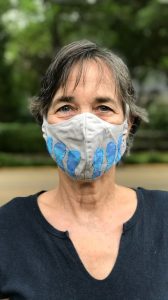I’m not a hugger. My mom was one; my dad was not. My husband is. I hug my husband, yes, and my daughters. But friends, as a way of saying hello or goodbye or thank you for dinner? No. I believe in using my words and speaking with my eyes to say, “Goodbye, I had a good time,” “Dinner was delicious” or “Let’s do this again.”
No need for me to invade someone else’s personal space or to have my personal space invaded, when I can say everything I want to say without touching.
I’ve been this way all my life. This is the American me. A European me that began after I married a Dutch man who studies German history is a little freer. I’ll buss someone’s cheek two or three times for hello and goodbye. Or when describing my best friend, I’ll say, “Sie ist meine Schwester. Ich liebe sie” (“She is my sister. I love her.”), which I would never say to or of her in English.
The COVID-19 pandemic is changing me. The European me has been bundled up since Christmas 2019, and the American me is beginning to long to touch human beings who are not married to me. Me, a non-toucher! A pat on the arm, a handshake, maybe even a kiss on the cheek in America. A game of “Pease Porridge Hot.” Heck, an incidental touch of fingers as I hand something to someone. I’ll wash my hands immediately afterwards, I swear.
The news magazine “The Week” had a recent contest asking people to come up with compound words to describe the times since last March. The winner was “Quarantired.” Second place was “multimasking.” My lab tech thought for less than a second when I described the contest to her before bursting out with “pandammit.”
Our way out of the pandammit, it seems to me, is through vaccines. We’ve all had vaccines before. Those of us who grew up going to public school in Mississippi had our measles-mumps-rubella vaccines – two of them. We had our polio vaccines and our tetanus-diphtheria vaccines. And here we still are. Vaccines are many, many, many times safer than the diseases they prevent.
If the country can vaccinate enough people so the SARS-CoV-2 virus does not have many susceptible people in whom to replicate – reproduce itself – the virus will be unable to replicate and therefore unable to mutate. The virus will die out, and the pandemic will come to an end.
It is a race to attain herd immunity and control of the virus before it mutates too far away from our current vaccines.
We live on a globe, in a global economy, with people who travel. This means that each country has to achieve herd immunity or to control the virus through mask-wearing, hand-washing, social distancing, and lockdowns.
We can’t leave one part of the world with groups of susceptible people because the virus will find them, more mutations can occur as the virus continues to replicate, and then the mutated virus will spread back to the rest of the world.
Even after someone has had his vaccine and waited two to three weeks after the second shot to achieve immunity, there is much we don’t know, and that is why we continue to mask, wash our hands and be careful to distance. The vaccine is good at preventing severe COVID-19. Can a vaccinated person carry live SARS-CoV-2 in his nose for zero days, one day, two days, five days or more and be a spreader?
How likely is it that a vaccinated person comes down with the South African variant B1.351 or the Brazilian variant P.1? If you have been vaccinated and your daughter has been vaccinated, can you hug each other? Can you eat at the same end of the table inside your dining room?
The current vaccines give immunity to an amazingly high 94%-95% of people, but how do you know if you are in the unlucky 5%-6%?
And more questions such as: How long will the immunity from the COVID-19 vaccines last? Will we need the vaccines every year like flu shots (probably not is the current estimate) or every 10 years like tetanus boosters? We don’t know.
What I do know is that vaccines have changed public health for the better, and that they are based on sound scientific principles. While I understand much of the underlying science behind the vaccines because of my years in medicine, there are certainly complexities that I don’t fully understand.
But I also don’t understand all the underlying science behind bridges, airplanes and elevators, yet I happily drive across bridges, take elevators and fly on airplanes.
Sometimes you take a leap of faith. As for me, I leapt. I got my second shot last Friday.
Dr. Jean G. Gispen is a staff physician at the employee health center within University Health Services at the University of Mississippi.
